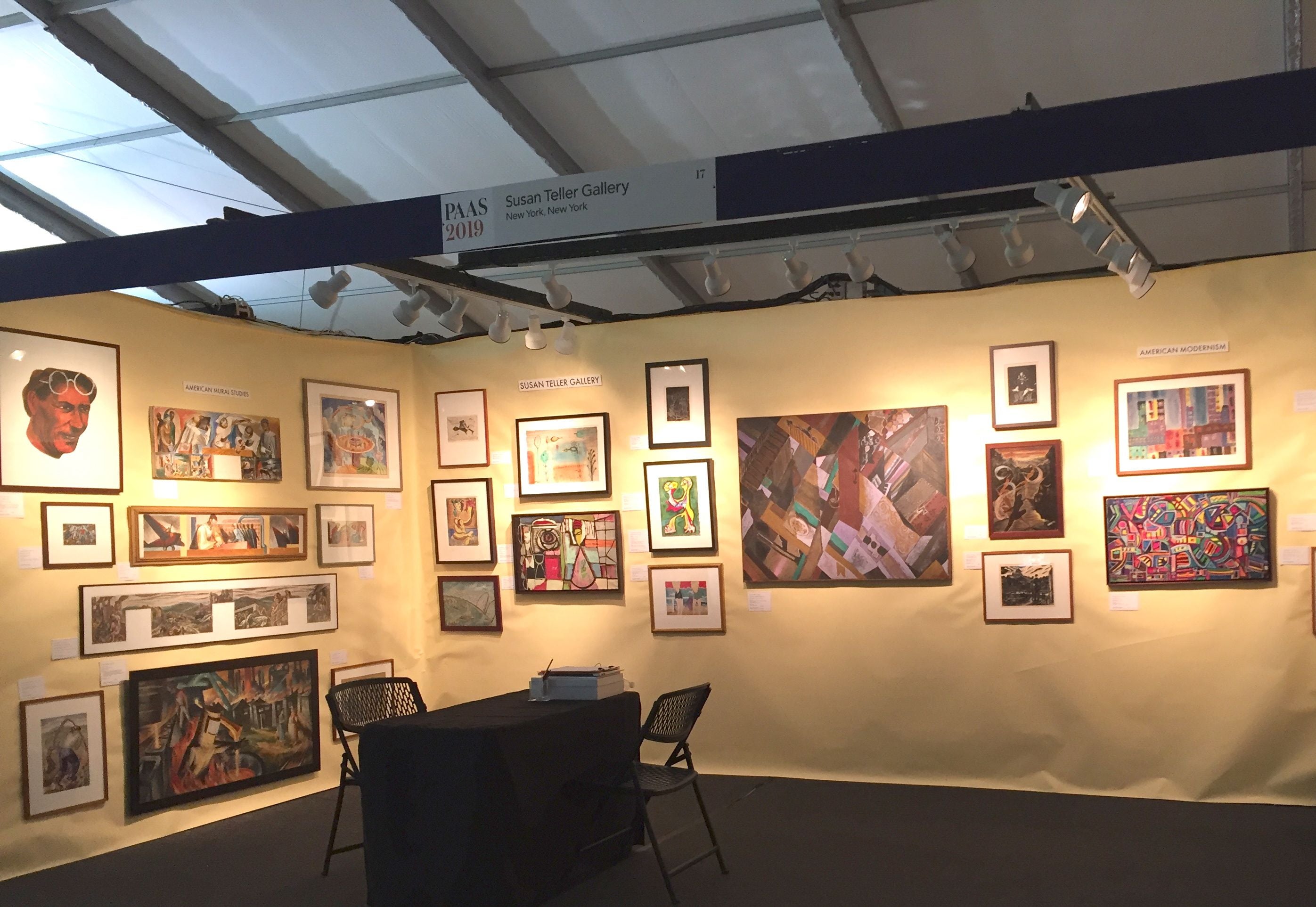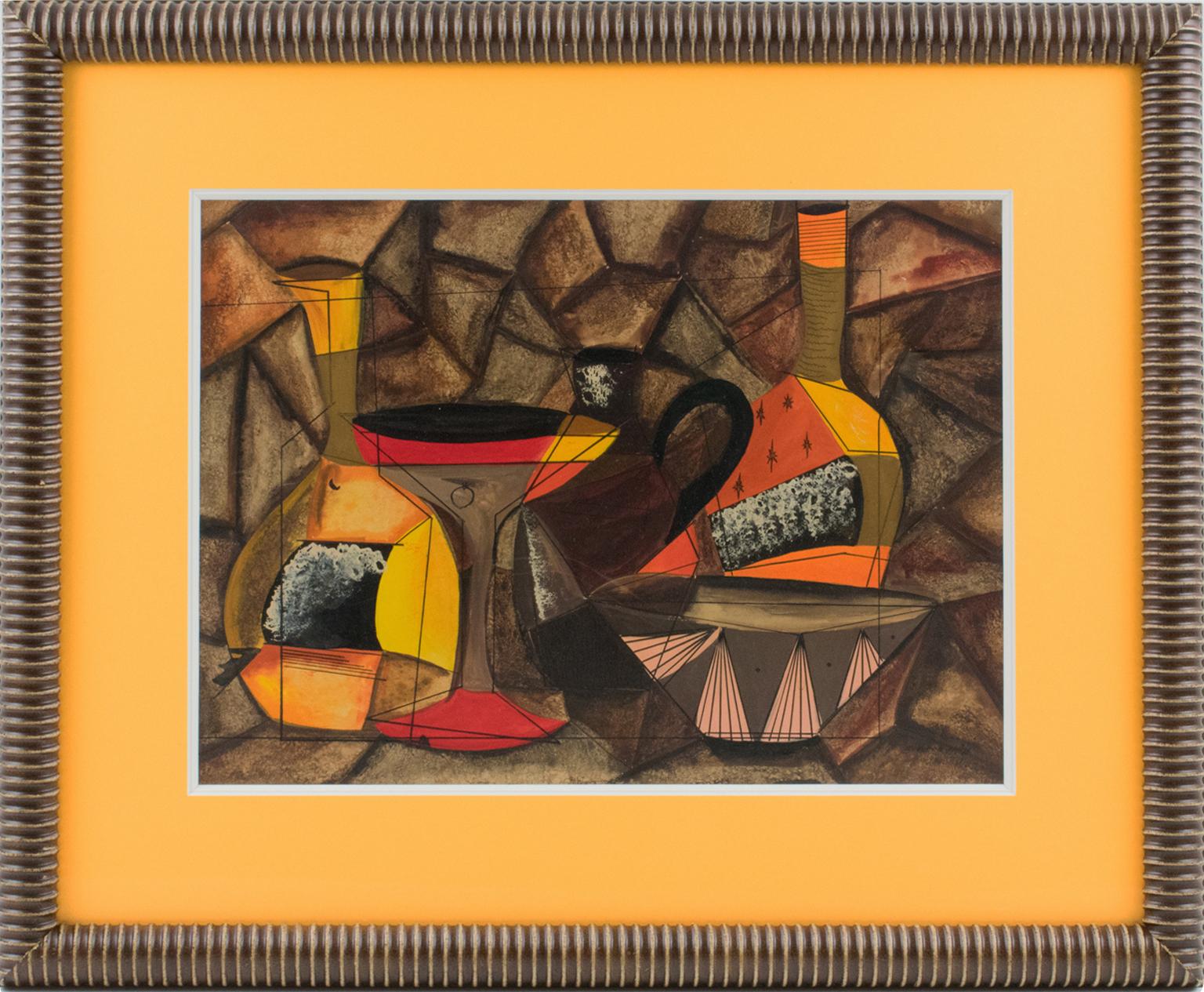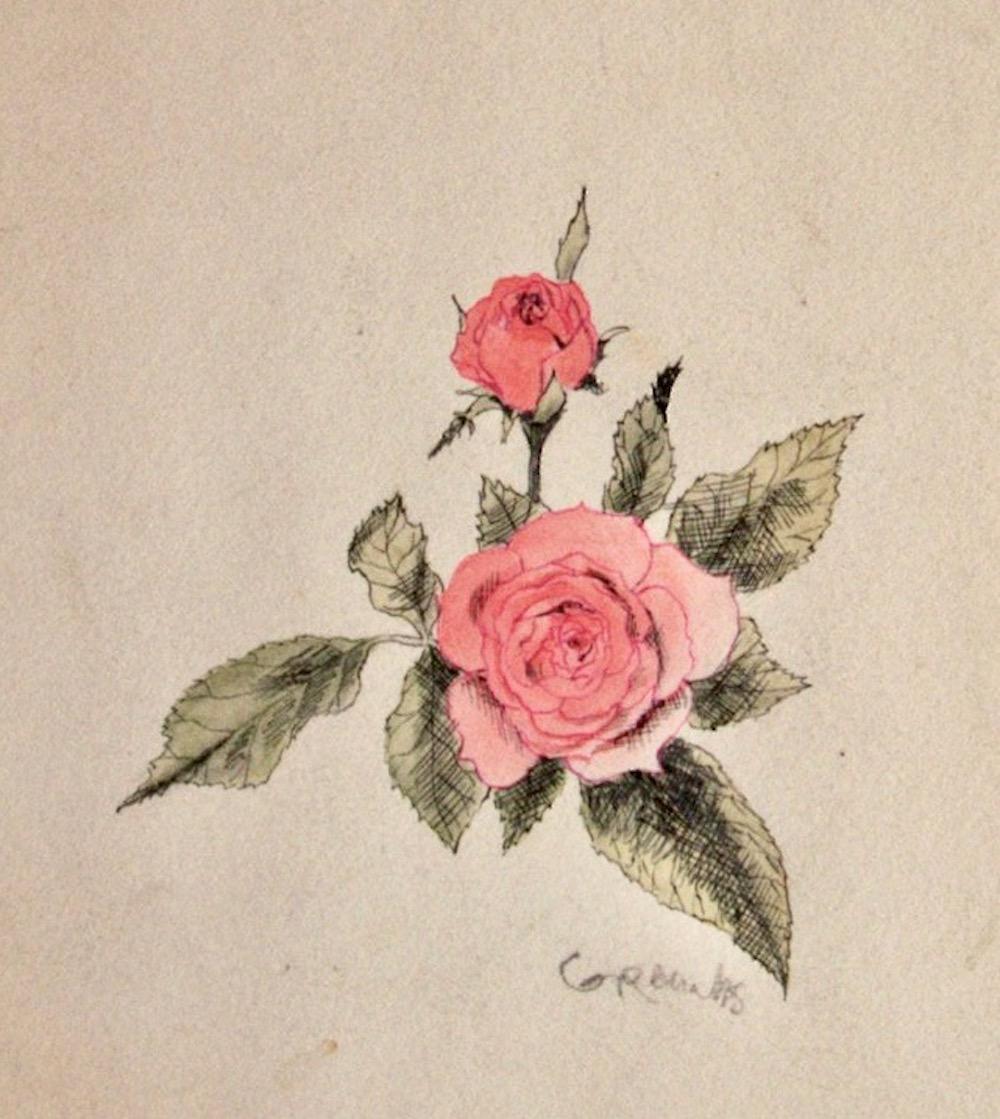Items Similar to Beulah Stevenson, Three Small Sunflowers and Two Roses by the Window
Want more images or videos?
Request additional images or videos from the seller
1 of 8
Beulah StevensonBeulah Stevenson, Three Small Sunflowers and Two Roses by the Window
About the Item
This Three Small Sunflowers still-life by Beulah Stevenson (1890-1965) is a joyful modernist composition. With just touches of color she indicates a window and colorful curtains blowing in the breeze. And we know it’s summer because the window is open and the flowers are from the garden, not a florist. Stevenson was a native New Yorker; she lived in Brooklyn her entire life and attended the Pratt Institute and the Art Students League where she worked with John Sloan. She also studied in Provincetown with Hans Hofmann, taught art at the Brooklyn Girls High School, and was a curator at the Brooklyn Museum. Her work is in the collections of the Brooklyn Museum (which gives her birth year as 1875), and the New York Public Library.
Signed in ink lower right; also signed and titled in ink on the reverse.
- Creator:Beulah Stevenson (1890-1965, American)
- Dimensions:Height: 19.5 in (49.53 cm)Width: 15 in (38.1 cm)
- Medium:
- Movement & Style:
- Period:
- Condition:Pin holes at corners, small break at lower right, with old tape on the reverse.
- Gallery Location:New York, NY
- Reference Number:1stDibs: LU141026639242

About the Seller
5.0
Platinum Seller
These expertly vetted sellers are 1stDibs' most experienced sellers and are rated highest by our customers.
Established in 1988
1stDibs seller since 2020
89 sales on 1stDibs
Typical response time: 3 hours
- ShippingRetrieving quote...Ships From: New York, NY
- Return PolicyA return for this item may be initiated within 7 days of delivery.
More From This SellerView All
- George Drittler, (Still Life)Located in New York, NYBritish-born, New Jersey-based, George Drittler was primarily know for landscapes. In this still life that expansive approach serves him well. Richly drawn, with pottery, books and a...Category
Mid-20th Century American Modern Still-life Drawings and Watercolors
MaterialsWatercolor
- Blanche Grambs, Pink RosesLocated in New York, NYBlanche Grambs developed a career in illustration and botanical studies were widely admired. However this work looks like it was made for her own enjoym...Category
Mid-20th Century American Modern Still-life Drawings and Watercolors
MaterialsWatercolor
- Blanche Grambs, (Lazy Susan)Located in New York, NYIn the 1950s and 60s Grambs worked on many commissions. This was probably for a cookbook. The dimensions are for the drawing. The sheet is somewhat larger, 7 x 6 1/2 inches.Category
Mid-20th Century American Modern Figurative Drawings and Watercolors
MaterialsInk
- Blanche Grambs, (Study for a Souffle)Located in New York, NYIn the 1950s and 60s Grambs worked on many commissions. The symmetrical nature of the drawing suggests it was for a book or magazine project with facing pages -- possibly a cookboo...Category
Mid-20th Century American Modern Figurative Drawings and Watercolors
MaterialsInk
- Blanche Grambs, (Shell Fish: Lobster, Crab, and Shrimp)Located in New York, NYIn the 1950s and 60s Grambs worked on many commissions. This ink drawing with a lobster, crab, and a shrimp, was probably for a cookbook; the sheet is cut in a free-form, modernist...Category
Mid-20th Century American Modern Figurative Drawings and Watercolors
MaterialsInk
- Blanche Grambs, (Cooking Still Life: Bread, Olives, Potato, Mushrooms)Located in New York, NYIn the 1950s and 60s Grambs worked on many commissions. This drawing was probably for a magazine, perhaps House and Garden or House Beautiful. It is signed and dated in pencil on the...Category
Mid-20th Century American Modern Figurative Drawings and Watercolors
MaterialsInk, Pencil
You May Also Like
- Sea Shells – Blue & GoldBy Zama Vanessa HelderLocated in Los Angeles, CASea Shells – Blue & Gold, c. 1940s, watercolor on paper, signed upper left, 15 x 19 ¼ inches (image); title and artist’s name and address inscribed verso, presented in a newer glazed...Category
1940s Modern Still-life Drawings and Watercolors
MaterialsPaper, Watercolor
- Original Painting Published Fortune Mag Cover 1935 Jewels Jewelry IllustrationBy Antonio PetruccelliLocated in New York, NYOriginal Painting Published Fortune Mag Cover 1935 Jewels Jewelry Illustration Antonio Petruccelli (1907 – 1994) Fortune cover published, Decembe...Category
1930s American Modern Still-life Paintings
MaterialsBoard, Gouache
- Cubist Still Life Gouache Painting by A Derek ChingLocated in Atlanta, GAA. Derek Ching (American, 20th Century) created this stunning, colorful cubist still life gouache on paper painting. With lovely fall colors, this subtle still-life composition featu...Category
Late 20th Century Modern Still-life Paintings
MaterialsGouache
- “Still Life with White Roses”Located in Southampton, NYBeautiful original watercolor by Jessie Harris Bone Charman. Signed lower right. Circa 1940. Condition is very good. Under glass. Beautifully matted and framed. Overall framed mea...Category
1940s Modern Still-life Drawings and Watercolors
MaterialsArchival Paper, Watercolor
- Garden FlowersBy Charles DemuthLocated in New York, NYCharles Demuth was one of the most complex, talented, and deeply sensitive artists of the American modern period. Whether he was painting floral still lifes, industrial landscapes, or Turkish bathhouses, art was, for Demuth, fraught with personal meaning. A fixture of the vanguard art scene in New York, Demuth navigated the currents of Modernism, producing some of the most exquisite watercolors and original oil paintings in twentieth-century American art. Demuth was born in Lancaster, Pennsylvania, the only child of a well-to-do family. He had an awkward and introverted childhood shaped by a childhood illness, Perthes, a disease of the hip that not only left him permanently lame, but, as part of the “cure,” bedridden for two years in the care of his mother. This long period of incapacitation had a deep impact on Demuth, who came to see himself as an invalid, an outsider who was different from everyone else. It was perhaps during this period of indoor confinement that his keen interest in art developed. Several relatives on his father’s side had been amateur artists, and, following his convalescence, his mother encouraged his artistic pursuits by sending him to a local painter for instruction. The majority of his early pictures are of flowers, a subject for which Demuth maintained a lifelong passion. Following high school, Demuth enrolled at the Drexel Institute of Art in Philadelphia, a school renowned for its commercial arts program. He advanced through the program rapidly, and, in 1905, at the encouragement of his instructors, he began taking courses at the Pennsylvania Academy of the Fine Arts. The two leading teachers then at the Academy were William Merritt Chase and Thomas Anshutz. Anshutz, himself a former student of Thomas Eakins, was well liked by his students, and is best known as the teacher of Robert Henri, John Sloan, and several of the other artists of the Ashcan School. Demuth, too, adopted a similar idiom, working in a controlled, realistic manner while at the Academy, where he remained until 1910. In 1907, Demuth made his first trip to Europe, staying in Paris. He spent time on the periphery of the art scene composed of the numerous American artists there, including John Marin and Edward Steichen. He returned to Philadelphia five months later, and immediately resumed courses at the Academy. Despite his introduction to advanced modern styles in Europe, Demuth’s work of this period retains the academic style he practiced before the trip. It wasn’t until he had summered at New Hope, Pennsylvania, in 1908 and 1911, that his style began to evolve. New Hope was a prominent American Impressionist art colony whose members were largely affiliated with the Pennsylvania Academy. Demuth dropped the conservative tone of his style and adopted a freer and more colorful palette. Although he remained based in Philadelphia, Demuth frequently went to New York during this period. Many of the same American artists of the Parisian art scene Demuth had encountered on his earlier European trip now formed the nucleus of New York’s avant-garde, which centered around Alfred Stieglitz’s 291 gallery. It wasn’t long before Demuth began to apply modernist-inspired strategies to his work. He was particularly influenced by the watercolor work of John Marin, also a former student of Anshutz, whose bold use of color in the medium Demuth freely adapted into looser washes of color. In 1912, Demuth again left for Paris, this time studying in the Académie Moderne, Académie Colorossi, and Académie Julian. In Paris Demuth met the American modernist Marsden Hartley. Hartley, a principal figure in the expatriate art circle, acted as a mentor to Demuth, and introduced him to the wide array of modern styles currently practiced in Europe. Hartley also introduced Demuth to many of the members of the Parisian avant-garde, including Gertrude Stein. Demuth was an aspiring writer, and he spent many hours in conversation with Stein. He wrote extensively during this period, and published two works shortly after his return to America. He also developed an interest in illustrating scenes from literary texts. From 1914 to 1919, Demuth produced a series of watercolors of scenes from books such as Emile Zola’s Nana and Henry James’s The Turn of the Screw. Upon his return to America, Demuth settled in New York. In 1914, Demuth had his first one-man show at Charles Daniel’s gallery, which promoted emerging modern American artists, including Man Ray, Rockwell Kent, Yasuo Kuniyoshi, Stuart Davis, and Max Weber. Demuth drew closer to the artistic vanguard in New York, becoming friends with many in the Stieglitz and Daniel circles, including Georgia O’Keeffe, Marcel Duchamp, Carl Van Vechten, and Edward Fiske. New York’s cosmopolitan atmosphere and active nightlife appealed greatly to Demuth. In a sketchy style well suited to watercolor, he painted many vaudeville and circus themes, as well as nightclub, café, and bathhouse scenes. Often with Duchamp, Demuth took part in an urban subculture replete with nightclubs, bars, drugs, and sexual permissiveness, which, for a homosexual artist like himself, allowed room for previously unattainable personal expression. Demuth’s pictures of sailors, bathhouses, and circus performers embody a sensual and sexual undercurrent, expressing the artist’s sense of comfort and belonging in the bohemian subculture of New York. Simultaneously, Demuth deepened his interest in floral pictures, painting these almost exclusively in watercolor. His style evolved from the broad color washes of his earlier pictures to more spare, flattened, and sinuous compositions, inspired by the drawings of Aubrey Beardsley and other artists of the Aesthetic Movement. Demuth’s flower watercolors are moody and atmospheric, sensuous and elegant, introspective and yet full of expressive power. Moreover they are beautiful, and are unequivocally among the finest still lifes in American art. Despite numerous subsequent artistic undertakings that led him in a variety of directions, Demuth never stopped painting flower pictures, ultimately adding fruits and other still-life objects to his repertoire. In 1916, Demuth began to develop a style later known as Precisionism, a form of landscape painting infused with Cubism, in which space is divided into precisely drawn geometric regions of color. Demuth first began to paint the landscape in an appropriated Cubist mode while on a trip with Hartley to Bermuda. In these early landscapes, in which the curvilinear forms of trees intersect the geometrically articulated architectural forms, Demuth explored ideas that shaped the future development of modernism in America. The full realization of Demuth’s explorations came after his return to America in 1917, when he turned his attention to industrial subjects. These works derive from a “machine aesthetic,” espoused by New York artists such as Francis Picabia, Joseph Stella, Albert Gleizes, and Duchamp, by which artists viewed machines as embodying mystical, almost religious significance as symbols of the modern world. Rather than painting the skyscrapers and bridges of New York as did most of his like-minded contemporaries, Demuth returned to his home town of Lancaster, where he painted factories and warehouses in a Precisionist idiom. The titles for these pictures are often contain literary references, which serve as clues for the viewer to aid in the decoding of the artist’s meaning. In 1923, Demuth planned a series of abstract “poster portraits” of his friends and contemporaries in the New York art and literary scene. In these “portraits,” Demuth combined text and symbolic elements to evoke the essential nature of his sitters’ distinguishing characteristics. In this fashion, he painted portraits of such artists as Georgia O’Keeffe, John Marin, and Arthur Dove. His most famous poster portrait, I Saw the Figure 5 in Gold...Category
20th Century American Modern Still-life Drawings and Watercolors
MaterialsPaper, Watercolor
- Still Life at a Table, Study in Yellow by Artist Harold HaydonBy Harold HaydonLocated in Chicago, ILA ca. 1931 delightful still life at a table; a study in yellow by artist Harold Haydon. Harold Emerson Haydon was born in Fort William, Ontario, Canad...Category
1930s American Modern Still-life Drawings and Watercolors
MaterialsPaper, Ink, Watercolor, Pen
Recently Viewed
View AllMore Ways To Browse
The Window
Brooklyn Museum
Windows New And Used
The Vintage Window
Vintage Brooklyn Museum
Small Window
New York Public Library
Three Windows
Small Mid Century Drawings
Flower Window
Painting Open Window
Paintings Of Open Windows
Flowers In The Window
Rose Vintage Drawing
Rose Window
Flowers Drawing Composition
Vintage Window Drawing
Vintage Garden Roses





